Chapter 10 Exact Inference Clique Trees
Recall: The basic operation of the variable elimination algorithm is the manipulation of factors.
- Multiplying existing factors $\to \psi_i$.
- Eliminate variable $\to \tau_i$.
Consider $\psi_i$ as a computational data structure $$ \dots \to \psi_j \xrightarrow{\tau_j} \boxed{\psi_i} \xrightarrow{\tau_i} \psi_l \dots $$
- takes “message” $\tau_j$.
- generated by other factors $\psi_j$.
- generates $\tau_i$.
Cluster Graphs
- A cluster graph $\mathcal{U}$ is an undirected graph such that:
- Each node is a cluster $C_i \subseteq \mathcal{X}$.
- Each edge between a pair of cluster $C_i$ and $C_j$ is associated with a sepset (separator set) $S_{i, j} \subseteq C_i \cap C_j$.
- Given set of factors $\Phi$, each factor $\phi_k \in \Phi$ must be assigned to one and only one cluster $C_{\alpha(\phi)}$ s.t. $Scope[\phi_k] \subseteq C_{\alpha(\phi)}$.
- The initial belief of a particular cluster as a product of all the factors assigned to it: $$ \psi_i (C_i) = \prod_{\phi: \alpha(\phi) = i} \phi $$
Sum Cluster might have no factor $\to$ null product and is equal to 1.
one and only one?
- It needs to be at least one so that the information is taken into account somewhere
- and it shouldn’t be more than one because if given to more than one cluster, the evidence will be double counted.
Example: Assign factors
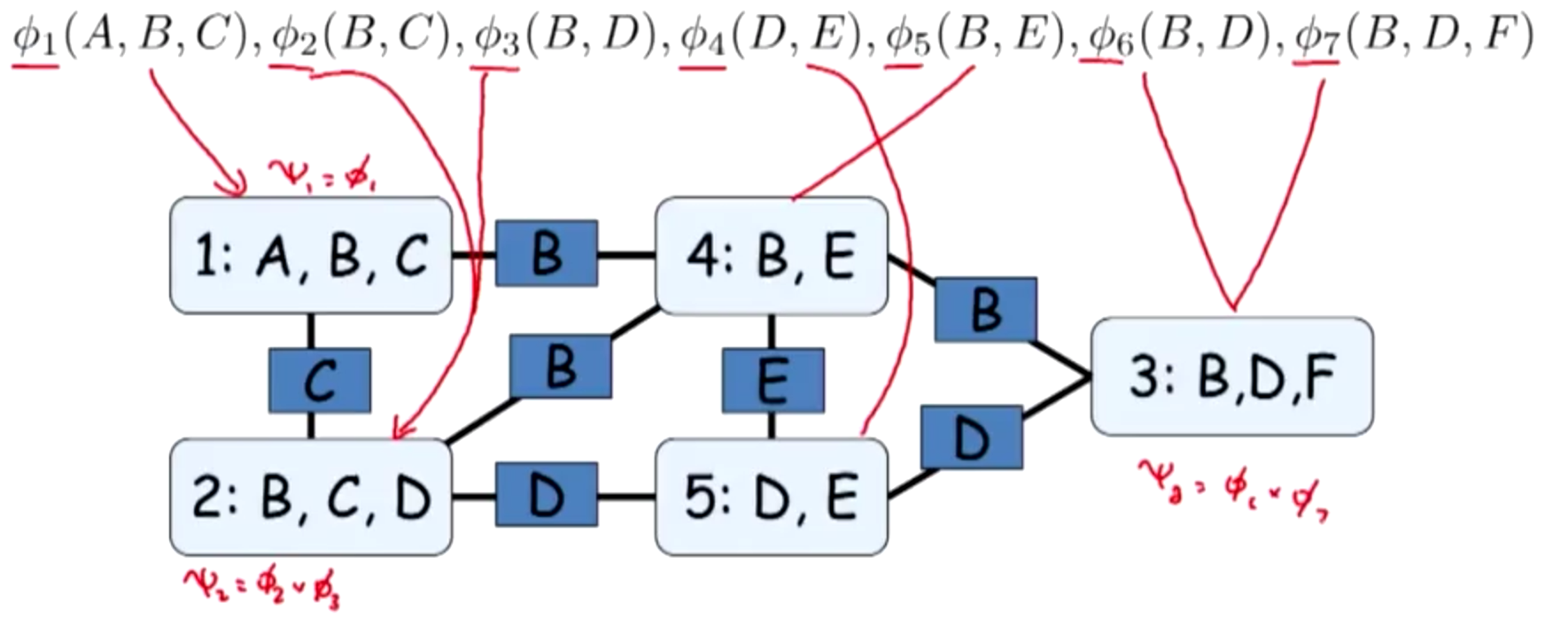
Student Example
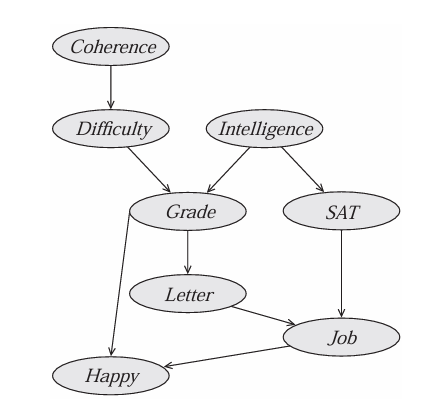

message $\tau_1(D)$
- generated from $\psi_1(C, D)$,
- participates in the computation of $ \psi_2 $
$ \Rightarrow $ edge $C_1 \to C_2$.
Properties of Cluster Graphs
Family Preservation
- Given set of factors $\Phi$, each factor $\phi_k \in \Phi$ must be assigned to one and only one cluster $C_{\alpha(k)}$ s.t. $Scope[\phi_k] \subseteq C_{\alpha(k)}$. (In English: Each factor $\phi_k$ needs to be assigned to a cluster $C_{\alpha(k)}$ s.t. $C_{\alpha(k)}$ accommodate $\phi_k$).
- For each factor $\phi_k \in \Phi$, there exists a cluster $C_i$ s.t. $Scope[\phi_k] \subseteq C_i$ (For each factor there’s a cluster accomodates $\phi_k$).
Clique Trees
The cluster graph associated with an execution of VE is guaranteed to have certain important properties.
- VE used intermediate factor $\tau_i$ at most once $\rightarrow$ the cluster graph induced by an execution of VE is necessarily a tree (there should be no cycle because if there’s more than one path from $C_i$ to $C_j$, $\tau_i$ will be used multiple times).
- Although cluster graph is undirected, an execution of VE defines a direction for the edges (flow of messages between clusters).
- The directed graph induced by the messages is a directed tree,
- all the messages flowing toward a single cluster where the final result is computed.
- This cluster is the root (not part of the definition of a cluster graph).
Clique Tree
- Cluster tree
such that:
- nodes are clusters $C_i \subseteq \mathcal{X}$ (called cliques),
- edges between $C_i$ and $C_j$ associated with sepset $S_{i, j} = C_i \cap C_j$,
- satisfies the running intersection property.
Tree
- connected: There is a path between every pair of nodes.
- acyclic: Contains no cycles - no path that starts and ends at the same node without retracing steps.
A cluster tree is a tree whose nodes are clusters (and this does not imply RIP, a cluster tree that satisfies RIP is a clique tree).
Properties of Clique Tree
1. Family Preservation
Cluster Graph Family Preservation property
2. Running Intersection Property (RIP)
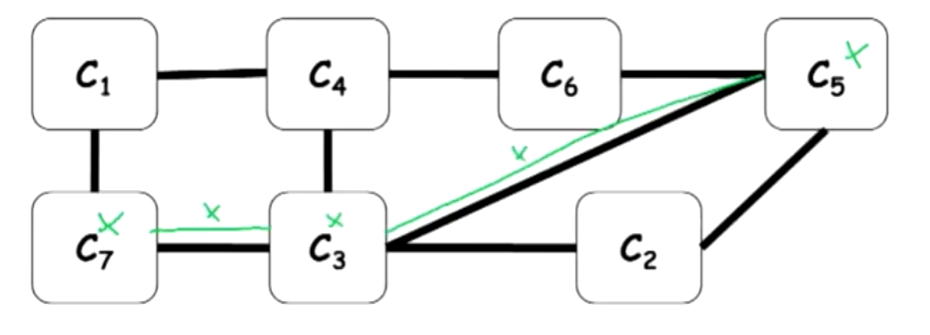
existence
Suppose $X \not\in S_{7, 3}$, there’s no way of $C_7$ to communicate to $C_3$ about the variable $X \rightarrow$ 2 seperate, isolated communities, each of which has some information about $X$ and they can never talk to each other about $X$, never going to get to agree about $X$.
That’s not very good, that path must exist.
uniqueness

Suppose there’re 2 paths involved $X$.
Consider cycle $C_3 \to C_5 \to C_2 \to C_3$.
- Suppose $C_3$ suggests that $X$ needs to take value 1, $C_5$ integrates with its own information and sends it to $C_2$ which sends it back to $C_3$.
- Now, $C_3$ reinforces its beliefs that $X$ need to take the value 1 $\to$ the probability goes up.
This self-reinforcing loop is going to give rise to very extreme and skewed probabilities in many examples $\Rightarrow$ One way to reduce this risk is to prevent these kinds of feedback loops.
RIP implies $S_{i,j} = C_i \cap C_j$
If the cluster satisfies RIP, then shared variables between $C_i$ and $C_j$ must persist through the path between them. Thus, $S_{i, j} = C_i \cap C_j$.an alternative view
For any $X$, the set of clusters and sepsets containing $X$ form a tree.
- It has to be connected because of the existence of the path.
- It can’t be a non tree because that would give us different paths.
- $X$: a variable in the model.
- $C$ and $C^{\prime}$: two clusters that contain $X$.
- $C_X$: the cluster where $X$ is eliminated $\to$ the cluster where $X$ is summed out during VE.
Goal: prove that $X$ must be present in every cluster on the path between $C$ and $C_X$ (and similarly, between $C^{\prime}$ and $C_X$).
Proof
- $C_X$ takes place later in the VE order than $C$, because
- $X$ got summed out (eliminated) in $C_X$, no factor generated afterward will contain $X$ in its domain.
- By assumption, $X$ is in the domain of $C$ + $X$ is not eliminated in $C$ $\to$ the message $\delta$ computed in $C$ must have $X$ in its domain.
- By definition, $\beta_i(C_i) = \psi_i \cdot \prod_{k \in Nb_i} \delta_{k \to i}$, $C$’s upstream neighbor’s scope contains $X$ since its belief equals its potential multiplied by the message from $C$.
RIP and Independence

Theorem 10.2
$ \mathcal{T} $ satisfies the running intersection property iff, for every sepset $ S_{i,j} $, we have that $W_{<( i, j )} \text{ and } W_{< (j, i) }$ are separated in $\mathcal{H} \text{ given } S_{i,j}.$
Message Passing: Sum Product
VE induces a clique tree.
Given a clique tree, how is this data structure used to perform VE?
Ready Clique
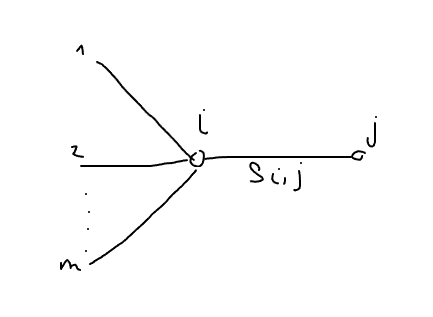
Clique-Tree Message Passing
- $\mathcal{T}$: clique tree with cliques $C_1, \dots, C_k$.
- $C_r$: selected root clique.
- For each $C_i$
- $Nb_i$: set of indexes of neighbors cliques.
- $p_r(i)$: upstream neighbor of $i$ (parent of node $i$ in the rooted tree $\mathcal{T}$).

1. Initialize Cliques: Multiplying the factors assigned to each clique $\alpha(\phi)$, resulting in the initial potentials $$ \boxed{\psi_j(C_j) = \prod_{\phi : \alpha(\phi) = j} \phi} $$
- Because each factor is assigned to exactly one clique, $$ \prod_{\phi} \phi = \prod_j \psi_j. $$
2. Message Passing Loop: Perform sum-product VE over the cliques
- Starting from the leaves, moving inward.
- Each clique $C_i$, except for the root, performs a message passing computation and sends a message to its upstream neighbor $C_{p_r(i)}$.
- The message from $C_i$ to $C_j$ is computed using sum-product message passing: $$ \boxed{\delta_{i \to j} = \sum_{C_i - S_{i, j}} \overbrace{\psi_i}^{\text{init clique potential}} \cdot \overbrace{\prod_{k \in (Nb_i - \{j\})} \delta_{k \to i}}^{\text{mess from other neigbors}} } $$ In other word, $C_i$ multiplies all incoming messages from its neighbors with its initial clique potential, resulting in a factor $\psi$ whose scope is the clique, sums out all variables except those in $S_{i, j}$ and sends the resulting factor as a message to $C_j$.
3. Compute Root Belief This message passing process proceeds up the tree, culminating at root.
-
When the root clique has received all messages, it multiplies them with its own initial potential.
-
Result: beliefs factor, computed using the expression
$$ \boxed{\beta_r(C_r) = \psi_r \cdot \prod_{k \in Nb(C_r)} \delta_{k \to r}} $$
$$ = \sum_{\mathcal{X} - C_r} \prod_{\phi} \phi = \tilde{P}_{\Phi}(C_r) $$
Upward pass of variable elimination in clique tree
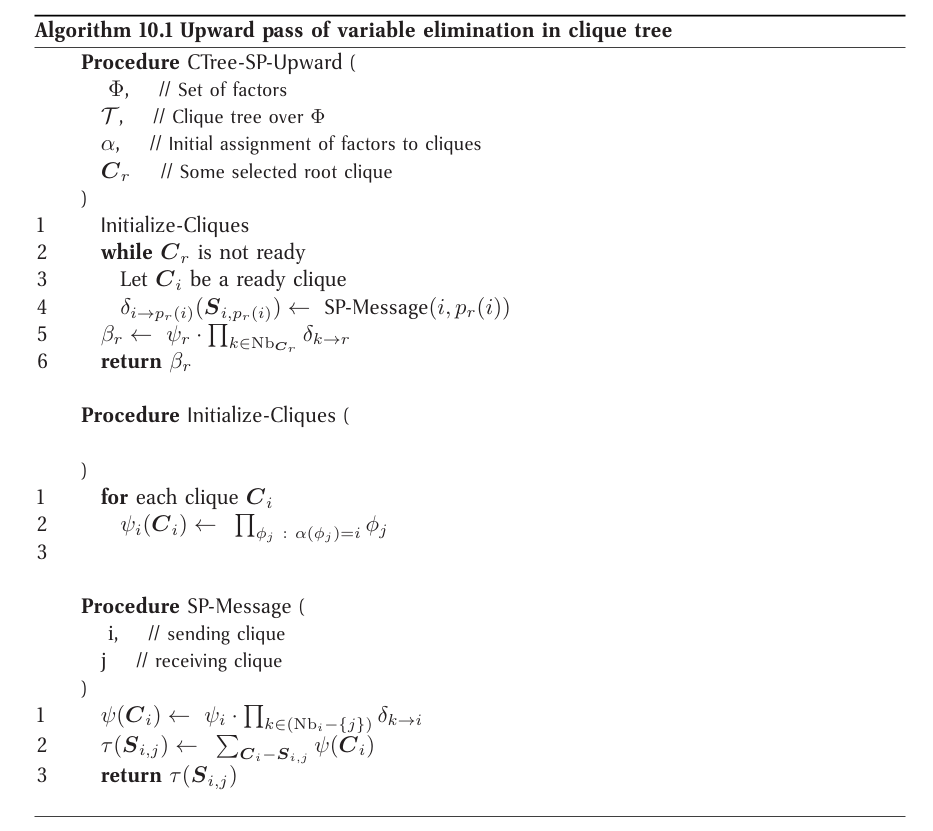
Example: simplified student network
One possible clique tree $\mathcal{T}$ for the simplified Student network
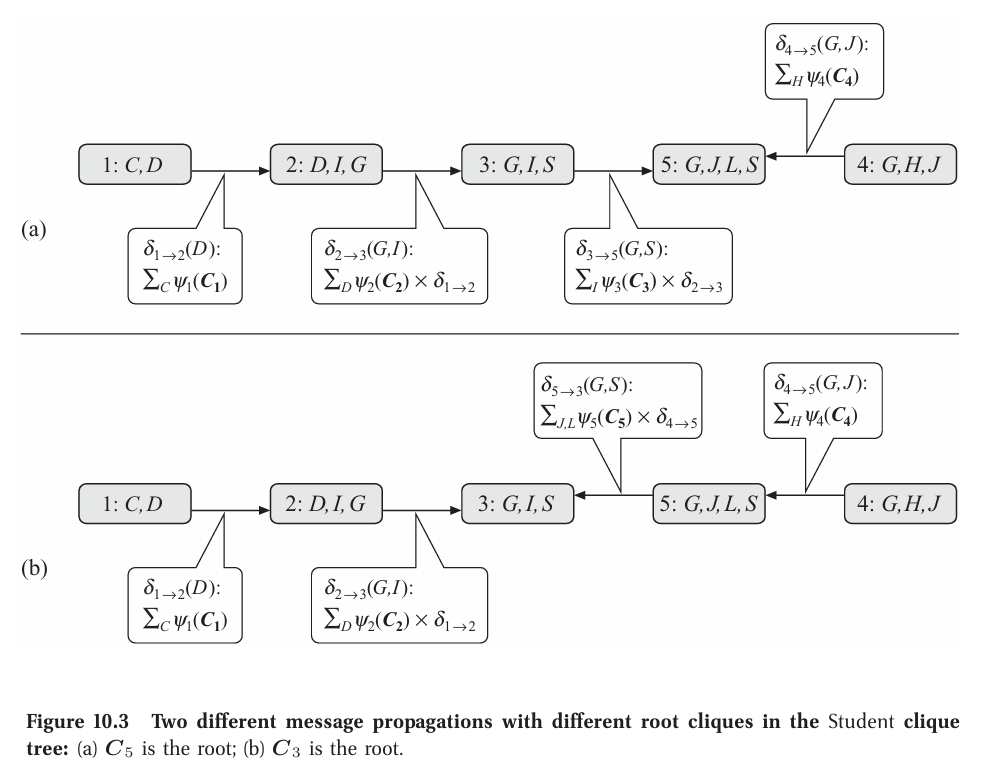
Generate a set of init potentials associated with the different cliques.
- $\psi_i(C_i)$ is computed by multiplying the initial factors assigned to the clique $C_i$
- For ex: $\psi_5(J, L, G, S) = \phi_L(L, G) \cdot \phi_J(J, L, S)$.
(a) Compute $P(J)$, choose some clique that contains $J$ as root clique, for ex, $C_5$.
- some legal execution ordering: $C_1, C_2, C_3, C_4, C_5$, $C_1, C_4, C_2, C_3, C_5$.
- illegal ordering: $C_2, C_1, C_4, C_3, C_5$.
- because $C_2$ is ready only after it receives its message from $C_1$.
In $C_5$: $$ \beta_5(G, J, S, L) = \delta_{3\to 5}(G, S) \cdot \delta_{4 \to 5}(G, J) \cdot \psi_5(G, J, S, L) $$
Can sum out $G, L, S$ to obtain $P(J)$.
Can choose $C_4$ as root. $$ \beta_4(H, G, J) = \delta_{5\to 4}(G, S) \cdot \psi_4(G, J, S, L) $$
(b) choose $C_3$ as root. $$ \beta_3(G, S, I) = \delta_{2 \to 3}(G, I) \cdot \delta_{5 \to 3}(G, S) \cdot \psi_3(G, S, I) $$
Compute posterior probability
- Pick a root in the clique tree that contain the desire variable.
- Pass messages upward toward that root.
- Extract marginals over variables that are in the root.
- The direction of messages depends on the root.
- The content of each message depends on what’s below the sender $\rightarrow$ changes if the root changes.
Say, if we want to know about the posterior probability of another variable that is in a different clique $\rightarrow$ choose another root and run the procedure again.
Correctness
Prove that this algorithm,
- when applied to a clique tree that satisfies
- the family preservation
- the running intersection property,
- will compute the desire expressions over the messages and the cliques (or say the resulting beliefs (marginals) are correct).
Assum $X$ is eliminated when a message is sent from $C_i$ to $C_j$,
Then $X$ does not appear anywhere in the tree on the $C_j$ side of the edge ($i - j$).
Proof using contradiction
Assume $X$ appears in some other clique $C_k$ that is on the $C_j$ side of the tree.
Then $C_j$ is on the path $C_i \to C_k$.
However a variable $X$ is eliminated only when a message is sent from $C_i$ to $C_j$ s.t:
- $X \in C_i$
- $X \not\in C_j$
$\Rightarrow$ $X$ appears in both $C_i$ and $C_k$ but not in $C_j$, violating the running intersection property.
The message $\delta_{i \to j}(S_{i, j})$ is equal to the sum over all variables on the $C_i$-side that are not in the sepset of the product of all factors on that side
$$ \delta_{i \rightarrow j}(S_{i,j}) = \sum_{\mathcal{V} \prec (i \rightarrow j)} \prod_{\phi \in \mathcal{F} \prec (i \rightarrow j)} \phi $$
where
- $\mathcal{F}_{\prec (i \to j)}$: all factors on the $C_i$-side of the edge.
- $\mathcal{V}_{\prec (i \to j)}$: all variables on the $C_i$-side of the edge but are not in the sepset.
In English, “The message from clique $C_i \to C_j = $ the sum over all variables on the $C_i$-side of the edge but are not in the sepset $S_{i, j}$ of the product of all factors on the $C_i$-side of the edge.”
Proof

The eliminated variables $\mathcal{V}_{\prec (i \to j)}$ in the entire subtree are:
$$ V_{\prec (i \to j)} = \left( \bigcup_{k = 1}^mV_{\prec (i_k \to j)} \right) \cup (C_i \ S_{i,j}) $$
- The variables eliminated at each subtree rooted at $i_k$ are $\mathcal{V}_{\prec(i_k \to i)}$.
- At $C_i$, we eliminate its local variables not in the sepset.
When we eliminate a variable at $ C_i $, it doesn’t appear in any subtree rooted at $ C_{i_k} $. So the variable sets $ \mathcal{V}_{<(i_k \to i)} $ are disjoint.
Assum $Y_i$ is eliminated at $C_i$
$$ \delta_{i \to j}(S_{i, j}) = \sum_{Y_i} \sum_{V_{\prec(i_1 \rightarrow i)}} \cdots \sum_{V_{\prec(i_m \rightarrow i)}} \left( \prod_{\phi \in F_{\prec(i_1 \rightarrow i)}} \phi \right) \cdots \left( \prod_{\phi \in F_{\prec(i_m \rightarrow i)}} \phi \right) \cdot \left( \prod_{\phi \in F_i} \phi \right) $$
$$ =\sum_{Y_i} \left( \prod_{\phi \in F_i} \phi \right) \cdot \sum_{V_{\prec(i_1 \rightarrow i)}} \left( \prod_{\phi \in F_{\prec(i_1 \rightarrow i)}} \phi \right) \cdots \sum_{V_{\prec(i_m \rightarrow i)}} \left( \prod_{\phi \in F_{\prec(i_m \rightarrow i)}} \phi \right) $$
- This is because the variable in $ \mathcal{V}_{<(i_k \to i)} $ do not appear in any factor $\phi$ that is not from the same subtree. So their summation does not affect the other factor, and we can pull out the summation inside (exchange summation and product).
Thus,
$$ \delta_{i \to j}(S_{i, j}) = \sum_{Y_i} \psi_i \cdot \delta_{i_1 \rightarrow i} \cdots \delta_{i_m \rightarrow i} $$
Corollary
- Because $\beta_r(C_r) = \psi_r \cdot \prod_{k \in Nb(C_r)} \delta_{k \to r}$.
- $\prod_{k \in Nb(C_r)} \delta_{k \to r} = \sum \prod \phi$.
$\Rightarrow$ The upward pass computes correct marginals for the root.
Sum up phần này nghĩa là nếu clique tree của mình thỏa mãn 2 tính chất … thì một message passing từ leaf đến root của nó sẽ là một legit marginal probability P~(X) …
Clique Tree Calibration
Belief Propagation

1. Initialize Cliques $$ \boxed{\psi_j(C_j) = \prod_{\phi : \alpha(\phi) = j} \phi} $$ 2. Message Passing Loop
- Repeat: Pass messages $ \delta_{i \to j} $ when $ C_i $ is ready. $$ \boxed{\delta_{i \to j} = \sum_{C_i - S_{i, j}} \psi_i \cdot \prod_{k \in (Nb_i - \{j\})} \delta_{k \to i} } $$
3. Compute beliefs
- After all messages passed, compute belief for each clique $$ \boxed{\beta_i(C_i) = \psi_i \cdot \prod_{k \in Nb_i} \delta_{k \to i}} $$
simplifed student example

At the end of this process, all messages and clique beliefs are computed. Messages used in the computation of $\beta_i$ are precisely the same as that would have been use in the upward algorithm, thus
Corollary 10.2
Calibrated
Cái này là belief tại cluster C_i nên vẫn bao gồm cả j, nghĩa là message từ 2 chiều vẫn khác nhau nhưng belief tại node đó sẽ = nhau nên vẫn cần tính message cả 2 chiều
Calibrated Clique Tree
Beliefs
clique beliefs $$ \boxed{\beta_i(C_i) = \psi_i \cdot \prod_{k \in Nb_i} \delta_{k \to i}} $$
Sepset beliefs
aka Marginal consistency constraint $$ \boxed{\mu_{i, j} (S_{i, j}) = \sum_{C_i - S_{i, j}} \beta_i (C_i) = \sum_{C_j - S_{i, j}} \beta_j (C_j)} $$
Clique Tree Analysis
Say we want to compute the posterior probability of all variables in the graphical models
Let $c$ be the cost of message passing to the root.
Naive message passing in clique tree: $nc$.
We can run the upward message passing algorithm once for every clique, making it the root: $Kc$.
- $K$: number of cliques.
Using clique tree calibration:
- Run message passing in two passes (upward pass and downward pass).
- Compute all messages
- The messages and beliefs in the clique tree store all necessary info about the posterior distribution.
- Then for any clique $C_i$, compute it belief $$ \beta_i = \psi_i \cdot \prod_{k \in Nb(i)} \delta_{k \to i} $$
- And then marginalize locally to get any variable in any clique. The cost of this algorithm is $2c$.
A Calibrated Clique Tree as a Distribution
- A data structure that stores the results of probabilistic inference for all of the cliques in the tree.
- An alternative representation of the measure $\tilde{P}_{\Phi}$
$$ \begin{align*} \mu_{i \to j}(S_{i,j}) &= \sum_{C_i - S_{i,j}} \beta_i(C_i) \\ &= \sum_{C_i - S_{i,j}} \psi_i \cdot \prod_{k \in Nb_i} \delta_{k \to i} \\ &= \sum_{C_i - S_{i,j}} \psi_i \cdot \delta_{j \to i} \cdot \prod_{k \in (Nb_i - \{j\})} \delta_{k \to i} \\ &= \delta_{j \to i} \cdot \sum_{C_i - S_{i,j}} \psi_i \cdot \prod_{k \in (Nb_i - \{j\})} \delta_{k \to i} \\ &= \delta_{j \to i} \cdot \delta_{i \to j} \end{align*} $$
Theorem 10.4
- $ T $: clique tree over $ \Phi $.
- $ \beta_i (C_i) $: set of calibrated potentials for $ T $.
If the potentials $ \beta_i (C_i) $ in a clique tree $ T $ are calibrated
Then $$ \tilde{P}_\Phi \propto Q_T $$
iff for each $ i \in V_T $,
$$ \beta_i (C_i) \propto \tilde{P}_\Phi (C_i) $$
Proof
- $ r $: root
We already knew that correct beliefs $ \rightarrow $ correct marginals at each cluster.
Global correctness of the distribution (reconstructing $ \tilde{P}_\Phi (X) $) is equivalent to local correctness of all cluster beliefs.
- Known each cluster beliefs matches the marginal $ \Rightarrow $ get the full unnormalized distribution correctly.
- Conversely, if the full distribution is correct $ \Rightarrow $ each belief must be a correct marginal.